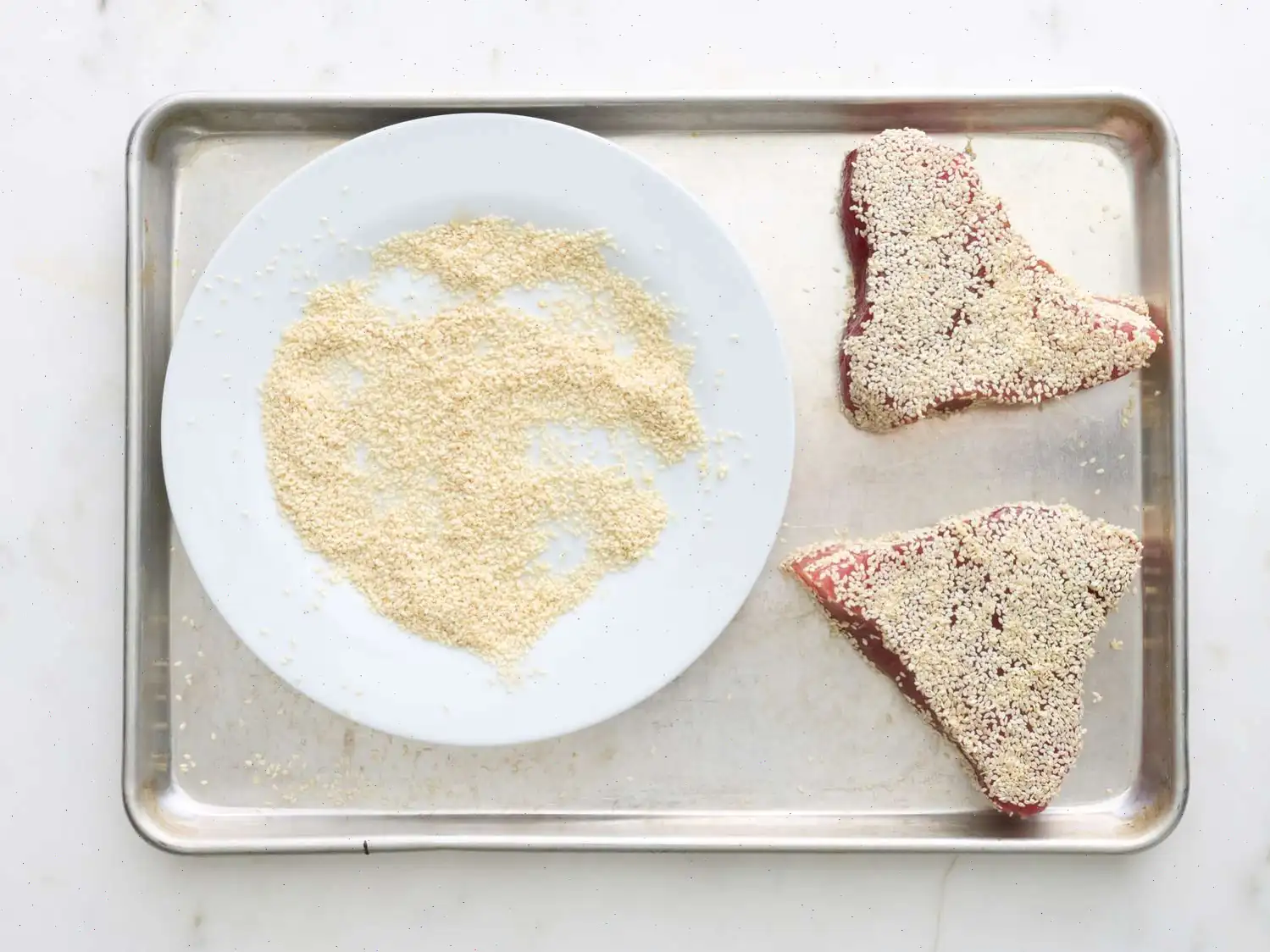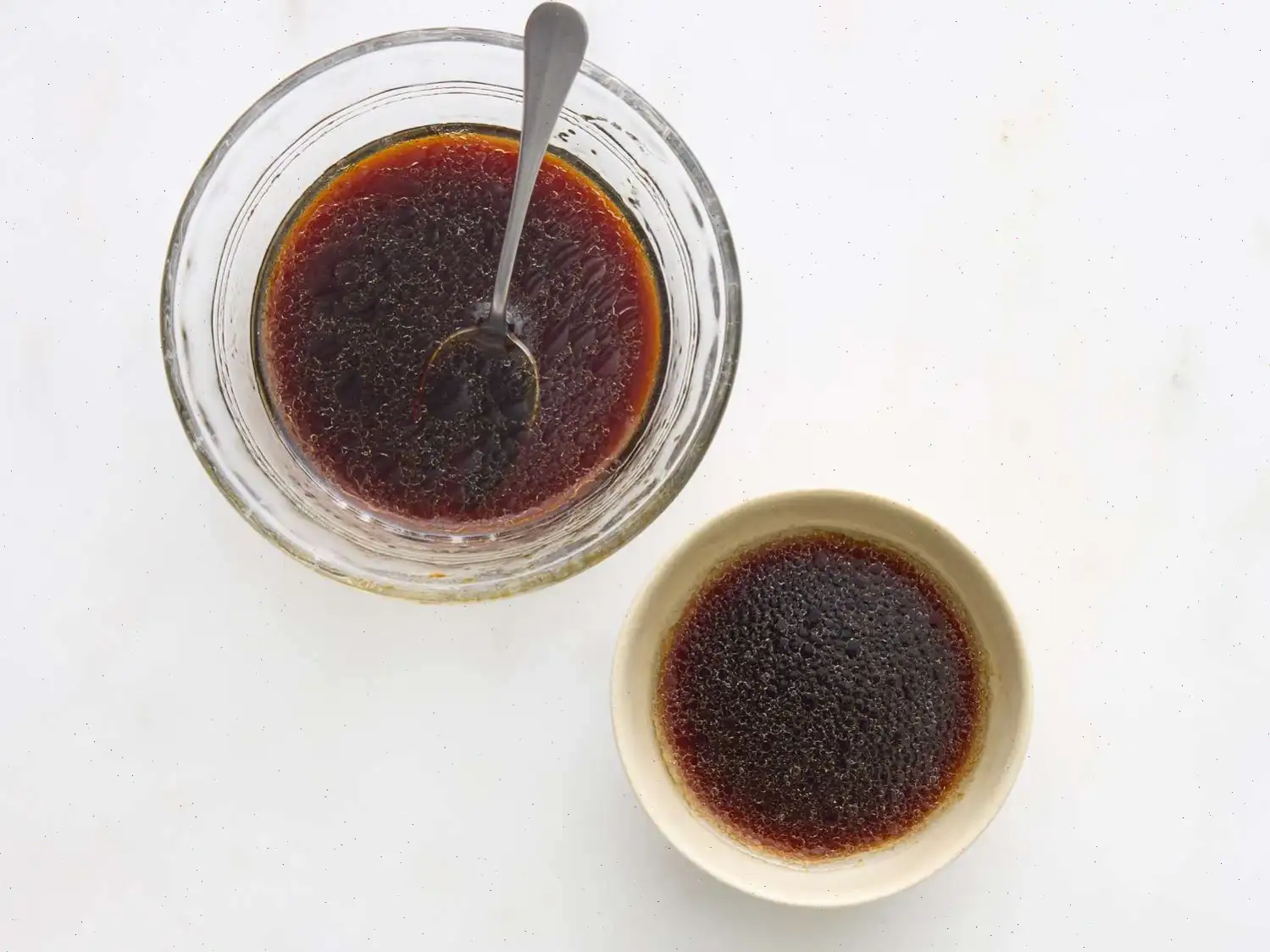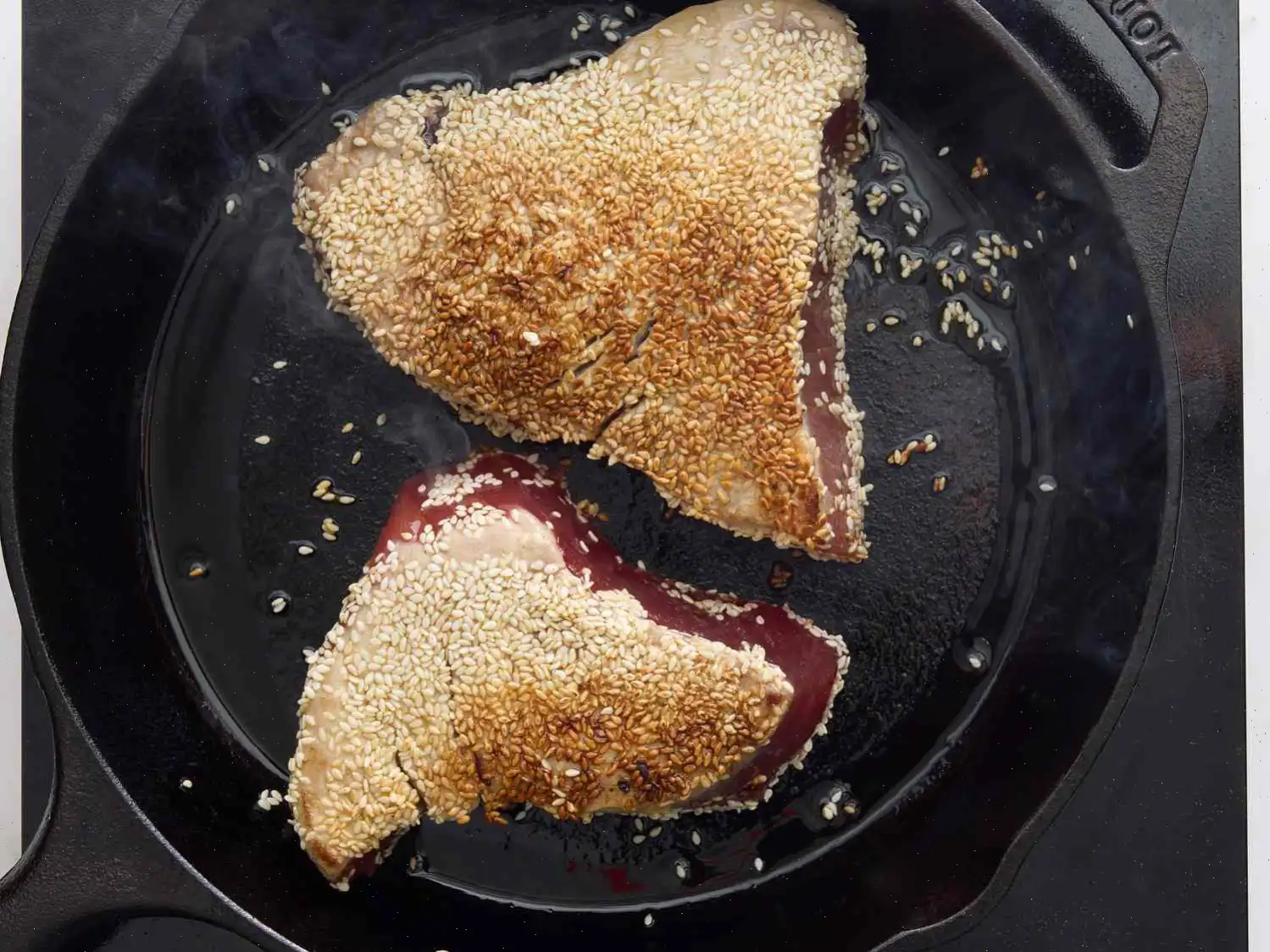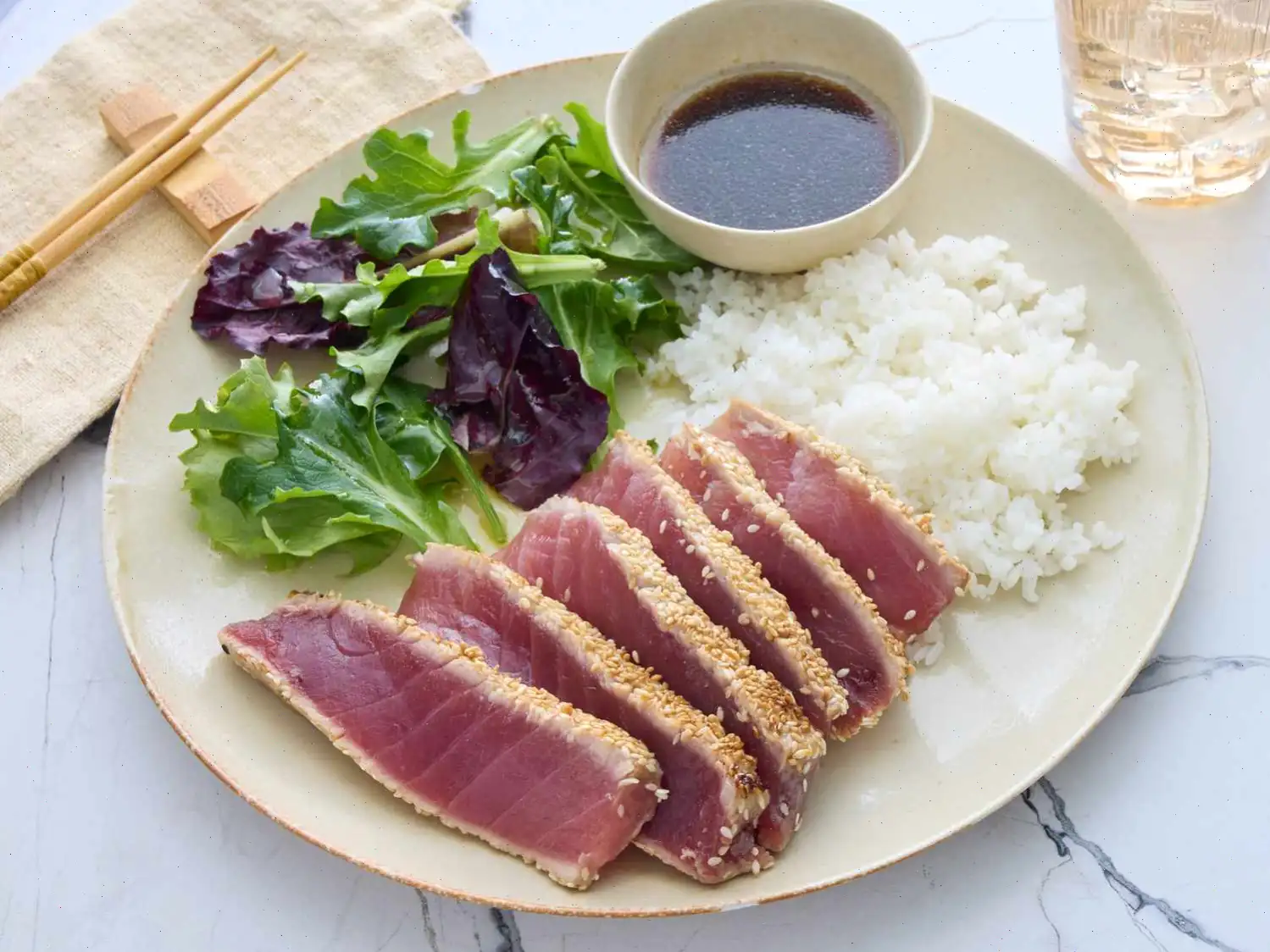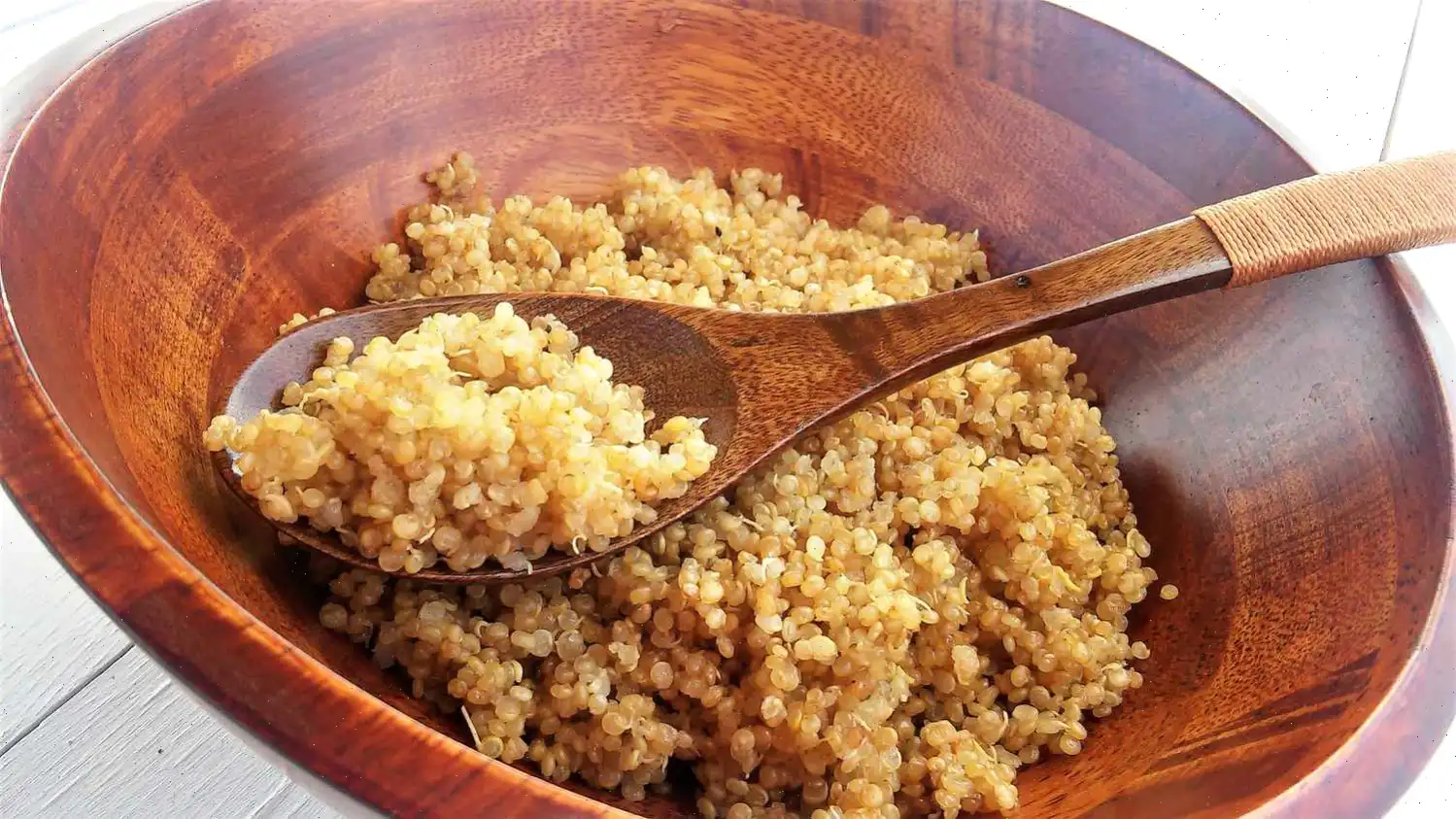
Sesame-Seared Tuna Recipe
Ingredients
- cup soy sauce
- 2 tablespoons sesame oil
- 1 tablespoon mirin (Japanese sweet wine)
- 1 tablespoon honey
- 1 tablespoon rice wine vinegar
- cup sesame seeds
- 4 (6 ounce) tuna steaks
- 1 tablespoon olive oil
- Wasabi paste
Directions
- Gather all ingredients.
- In a small bowl, mix together soy sauce, sesame oil, mirin, and honey.
- Pour half of the soy sauce mixture into another small bowl, stir in rice wine vinegar, and set aside as a dipping sauce.
- Spread sesame seeds out on a plate.
- Coat the tuna steaks with the remaining soy sauce mixture, then press them into the sesame seeds to fully coat.
- Heat olive oil in a cast iron skillet over high heat until it is very hot.
- Place the tuna steaks in the skillet and sear each side for about 30 seconds.
- Serve the tuna steaks with the dipping sauce and wasabi paste on the side.
Nutrition Facts (per serving)
| Calories | 422 |
| Total Fat | 21g (27%) |
| Saturated Fat | 3g (16%) |
| Cholesterol | 77mg (26%) |
| Sodium | 1046mg (45%) |
| Total Carbohydrate | 13g (5%) |
| Dietary Fiber | 2g (8%) |
| Total Sugars | 6g |
| Protein | 44g (88%) |
| Vitamin C | 1mg (2%) |
| Calcium | 207mg (16%) |
| Iron | 4mg (23%) |
| Potassium | 879mg (19%) |
* Percent Daily Values are based on a 2,000 calorie diet. Your daily values may vary depending on your calorie needs.
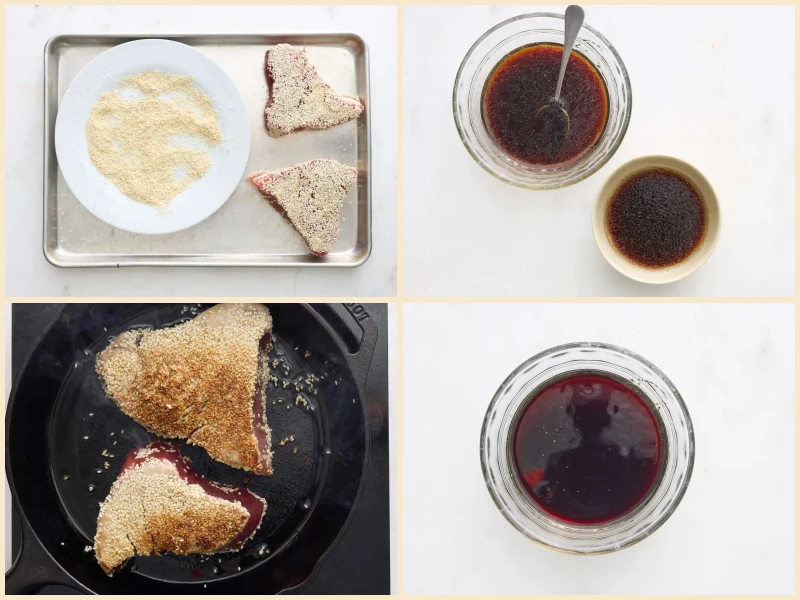
The Sesame-Seared Tuna recipe offers a delicious fusion of Japanese flavors and culinary techniques. This dish, known for its crisp, sesame-crusted exterior and tender, raw-centered tuna, embodies the balance of texture and taste that is central to Japanese cuisine. Whether served as a light appetizer or a main course, it delivers an elegant and savory experience. But where did this delectable dish originate? What are its regional variations and how does it differ from similar dishes? Lets dive into the fascinating world of sesame-seared tuna.
Origin and History
The origins of sesame-seared tuna are rooted in Japan, a country known for its appreciation of fresh seafood and bold flavors. Tuna has been a staple in Japanese cuisine for centuries, especially in dishes like sushi and sashimi. The technique of searing tuna, while leaving the center rare or raw, is part of a broader tradition of preparing fish with minimal cooking to retain its natural flavors. The sesame crust, introduced to the dish, adds a crunchy texture and a nutty depth of flavor, making it a contemporary twist on traditional Japanese seafood preparations. The dish has grown in popularity worldwide, particularly in upscale restaurants and fusion kitchens.
Regional Features
In Japan, the use of sesame seeds is prevalent in many culinary preparations. From savory dishes to desserts, sesame plays a significant role in the cuisine. The sesame-seared tuna is often associated with coastal regions, where fresh tuna is readily available. However, it has become a popular dish across various countries, particularly in Western kitchens, due to its simple yet sophisticated flavor profile. In some regions, chefs may add extra elements such as a citrus-based sauce or pickled vegetables to complement the fishs rich texture.
How it Differs from Similar Dishes
While tuna is widely used in Japanese dishes such as sushi and sashimi, sesame-seared tuna stands apart because of its preparation method. Unlike sushi or sashimi, where the tuna is served raw, sesame-seared tuna is briefly seared on the outside, creating a contrast between the crunchy sesame crust and the raw interior. This technique gives the tuna a smoky flavor while maintaining its tender, melt-in-the-mouth texture. It is also distinct from other seared fish dishes, such as tuna steaks, which are typically cooked through. The brief searing and the use of sesame seeds make it a unique and refined dish.
Where Its Typically Served
Sesame-seared tuna is often served in fine dining restaurants, sushi bars, and contemporary fusion kitchens. In Japan, it may be offered as part of a larger seafood platter or as an appetizer in sushi restaurants. Outside of Japan, this dish has become a popular choice in upscale restaurants, especially those focusing on fresh seafood and Japanese-inspired fusion cuisine. It is often paired with light sides such as wasabi mashed potatoes, a fresh green salad, or rice. The tuna can also be served with dipping sauces like soy sauce, ponzu, or spicy wasabi sauce to enhance its flavors.
Interesting Facts
1. Health Benefits: Tuna is an excellent source of lean protein, omega-3 fatty acids, and essential vitamins, making this dish not only delicious but also nutritious. The addition of sesame seeds offers extra health benefits, including fiber and antioxidants.
2. Popularity in Western Cuisine: While originally a Japanese creation, sesame-seared tuna has gained immense popularity in Western countries, particularly in the United States. It has become a staple at seafood restaurants and is even featured in various gourmet cookbooks.
3. Versatility: Although sesame-seared tuna is traditionally prepared with tuna steaks, chefs often experiment with different types of fish such as salmon, swordfish, or even mahi-mahi. The technique of searing with sesame seeds is versatile and can be adapted to other proteins.
FAQ about Sesame-Seared Tuna Recipe
Comments
Emma Robinson
11/22/2024 07:19:01 AM
This recipe was fantastic, but I do have a few recommendations to make it even better. I decided to add a bit more honey and reduce the amount of sesame oil to just a tablespoon or less. I also made sure to include mirin, low-sodium soy sauce (as it was what I had on hand), and rice wine vinegar. Adding some wasabi paste to both the marinade and dipping sauce is essential for an extra kick of flavor. To ensure that the steaks cooked perfectly, I cut them to a thickness of about 1/2 to 3/4 inches and seared them for around 40 seconds. Thicker steaks tended to burn on the outside before cooking through to my preferred level of doneness (pink, not red in the middle). It's important to preheat the cast iron, but be mindful of reducing the heat to medium-high to prevent excessive smoke and setting off the smoke alarms. I found that sesame seeds didn't add much to the dish and tended to pop everywhere during searing, creating a mess. However, if you must use them, lightly toast them beforehand, then sprinkle them on the seared steaks just before serving to avoid a cleanup ordeal. I served the dish with plain rice or a mix of long grain and wild rice, which was perfect for soaking up the delicious dipping sauce. Overall, a wonderful recipe with a few tweaks to customize it to your liking.
Emma Gomez
09/11/2022 02:24:45 AM
I have prepared this recipe countless times over a span of more than a decade, and it continues to impress. I've made some modifications over time that have elevated the dish for my taste. One aspect that bothered me was the overly liquid consistency of the drizzling sauce, which tended to slide right off the fish and onto the plate. Recently, I decided to try a tip from Cooks Illustrated to thicken it into a glaze by increasing the sauce amount by 50%. After dividing the sauce into the portions for marinating and drizzling, I mixed the drizzling portion (containing rice vinegar) with a small amount of cornstarch in a pan and brought it to a boil. By simmering it until it thickened, I achieved a glaze that could be applied to coat the fish similar to the way restaurants do it, ensuring it stayed in place. The difference was remarkable!
Stephen Harris
08/17/2022 05:39:14 AM
I had never attempted to make a dish like this before, but after trying it at a restaurant, I used this recipe to recreate it at home. The result was fantastic! I made a couple of substitutions - I used white wine instead of mirin as I couldn't find it at my local store, and I toasted the sesame seeds and pressed them onto the seared ahi right after cooking. I served it with wasabi mashed potatoes and a crunchy slaw with a quick vinaigrette. In terms of quality, I tried making this with frozen ahi because I wasn't sure how it would turn out, and I didn't want to risk ruining a nice piece of fish. I prepared the marinade without vinegar and let the thawed fish marinate at room temperature for 2 hours. For the actual meal, I made a fresh batch of the sauce, this time with vinegar, for dipping. While the frozen ahi tasted great, I think using higher-quality fresh fish would have made a difference in the texture. Overall, we enjoyed it and plan to make it again with better quality fish next time.
Rebecca Nelson
10/29/2024 11:27:41 PM
Delicious! I had to replace mirin with white wine since I didn't have any, and I also added a bit of rice wine vinegar to the cooking and dipping sauces. I will definitely try it with mirin next time. I marinated the steaks in the sauce for about 30 minutes. Since my husband doesn't like rare meats, I cooked the tuna steaks for approximately 3 minutes per side for a medium-rare finish. We enjoyed them with rice noodles and stir-fried veggies, and they were a big hit! Thank you for sharing this recipe!
Catherine Robinson
03/01/2025 09:05:49 AM
I have tried this recipe twice already and it was so simple and delicious! I followed the recipe almost exactly, but after reading some other reviews, I decided to toast the seeds first. I also doubled the dipping sauce, just to have extra - though the original amount would have been sufficient. The tuna turned out delicious; I cooked it for 45 seconds on each side since my steaks were 1.5 inches thick. This recipe is definitely a keeper! Thanks, neworleansgiglet.
Samuel Gonzalez
04/06/2025 10:16:56 PM
Review Update: I found this recipe to be quite enjoyable, especially when paired with the delicious dipping sauce. Personally, I felt that the sesame seed crust was a bit overwhelming. I followed the advice of others and only used 1 tablespoon of sesame oil. Next time, I plan to sprinkle the sesame seeds lightly on the steaks for a more even and lighter coating. My wife absolutely adored the dish and was impressed by the perfect sear on the steak. I recommend keeping the cooking time short on each side over medium-high heat for best results!
Christine Diaz
05/26/2025 01:16:11 PM
This dish turned out incredibly amazing! I prepared a Ponzu marinade using soy sauce, sesame oil, lemon juice, and wasabi. I dipped the steak in the sauce for a few seconds and coated it with seeds, ensuring the steak was fully covered. I cooked it over medium-high heat in a pan until slightly toasted on each side.
Karen King
08/23/2022 09:47:53 AM
I have a suggestion to enhance this technique. Consider using tongs to sear the sides of the tuna as well. This simple step only takes a few seconds, improves the presentation, and helps prevent overcooking the tuna. By searing the sides, you can achieve a more appealing look without keeping the tuna flat in the pan for too long.
Mary Gonzalez
10/28/2024 10:06:24 AM
I have made this recipe twice in the past month, determined to get it right! The first time, the high heat and olive oil caused excessive smoke, and searing the tuna steaks for just 30 seconds on each side led to burnt sesame seeds. For my second attempt, I switched to avocado oil for frying and mixed the wasabi into the soy sauce dipping sauce, which made a huge difference. I used rice vinegar instead of mirin since I couldn't find it, and the meal turned out fantastic! With these adjustments, I will definitely be making it again.
Justin Hernandez
09/28/2024 11:44:42 PM
We absolutely adored this recipe! We opted for tamari instead of soy sauce due to gluten sensitivities, and it turned out absolutely perfect. The whole family loved it. I paired it with avocado slices, salad, and oranges, and it was a huge hit. I can't wait to make it again!
Jerry Scott
07/19/2023 07:05:04 PM
I decided to enhance the flavor by increasing the amount of honey and substituting balsamic vinegar for Mirin.
Heather Parker
02/21/2025 01:20:14 AM
Absolutely delicious! I suggest searing it for about 15 seconds (or more) on each side. It was truly fantastic.
Brenda Hall
08/23/2022 08:54:45 PM
Here's the rewritten review: I have prepared this dish numerous times and absolutely adore it. While browsing through reviews, I came across one that recommended slicing the tuna fillets into thinner pieces and skipping the sesame seeds. Everyone has their own preferences. I personally find it easy to achieve the perfect level of doneness when cooking the fish in my trusty old cast iron skillet. I prefer my tuna to be rare to medium rare. I have never encountered any issues with the sesame seeds I use. However, I do recommend being a bit cautious with the amount of soy sauce added, as it can overpower the delicate flavor of the tuna. For the best experience, make sure not to overcook the fish.
Timothy Torres
12/25/2022 04:49:46 AM
Raising 'rare' fish to the perfect level of doneness can be tricky, but cooking it any longer would risk making it dry and less flavorful. So, I say yes, keeping it pink is the way to go because it is absolutely delicious!
George Diaz
05/05/2023 12:31:58 PM
Followed the instructions perfectly, but unfortunately my frying pan caught on fire.
Raymond Collins
10/14/2022 05:08:49 PM
Absolutely delicious! My husband caught fresh blackfin from the Gulf, and this recipe blew us away! It was like a taste of heaven on earth!
Mark Thomas
06/13/2023 10:27:30 PM
I absolutely adored it! I followed the recipe to a tee. I've always wanted to try making tuna like this and I'm so happy I found this recipe!
Virginia Taylor
02/06/2024 03:33:52 PM
My favorite recipe for seared tuna. I adore how simple it is to prepare this dish. The flavors are fantastic. I typically pair it with a Wakame Salad, pickled ginger, wasabi, and Sriracha sauce.
Nicholas Hill
04/22/2025 09:00:45 AM
Super simple and incredibly tasty


